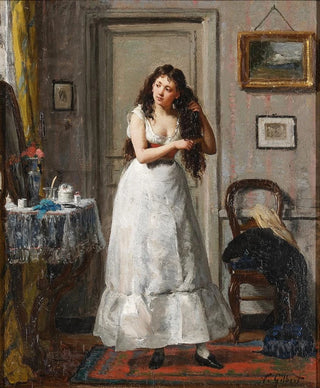Art print | At her toilette - Victor Gabriel Gilbert


View from behind

Frame (optional)
The artwork "À sa toilette" by Victor Gabriel Gilbert is a true ode to feminine beauty and intimacy. In this delicate scene, the artist manages to capture a moment of life, a pause in a woman's daily routine as she prepares. The soft light enveloping the subject, along with the chosen color palette, evoke an atmosphere of serenity and reflection. Gilbert, with his mastery of the brush, invites us to share this suspended moment, to delve into the intimate universe of his protagonist. This piece, both simple and profoundly emotional, resonates with anyone who has ever lost themselves in contemplating the fleeting beauty of life.
Style and uniqueness of the work
Victor Gabriel Gilbert's style is distinguished by its meticulous realism and attention to detail. In "À sa toilette," every element, from the mirror to the accessories, is treated with precision that reveals a deep understanding of light and space. The textures of the clothing, the softness of the skin, and even the ambient luminosity are rendered with such finesse that they seem almost tangible. Gilbert skillfully plays with shadows and reflections, creating a harmonious composition that draws the eye to the contemplative face of the woman. This painting embodies a rare artistic sensitivity, where each brushstroke reflects a quest for beauty and admiration for femininity. The scene, though everyday, is elevated to an art level that invites contemplation and reflection.
The artist and his influence
Victor Gabriel Gilbert, born in 1847, was a French painter whose work left a mark on his era. Raised in an artistic environment, he absorbed influences of his time while developing a personal style. Gilbert is often associated with the French school of the 19th century, where realism and Impressionism coexisted. His work, rich in emotion and detail, demonstrates a desire to capture the beauty of the world around him. He was also a keen observer of daily life, which is reflected in his choice of subjects. By painting intimate scenes, he contributed to redefining the representation of women in art, presenting

Matte finish

View from behind

Frame (optional)
The artwork "À sa toilette" by Victor Gabriel Gilbert is a true ode to feminine beauty and intimacy. In this delicate scene, the artist manages to capture a moment of life, a pause in a woman's daily routine as she prepares. The soft light enveloping the subject, along with the chosen color palette, evoke an atmosphere of serenity and reflection. Gilbert, with his mastery of the brush, invites us to share this suspended moment, to delve into the intimate universe of his protagonist. This piece, both simple and profoundly emotional, resonates with anyone who has ever lost themselves in contemplating the fleeting beauty of life.
Style and uniqueness of the work
Victor Gabriel Gilbert's style is distinguished by its meticulous realism and attention to detail. In "À sa toilette," every element, from the mirror to the accessories, is treated with precision that reveals a deep understanding of light and space. The textures of the clothing, the softness of the skin, and even the ambient luminosity are rendered with such finesse that they seem almost tangible. Gilbert skillfully plays with shadows and reflections, creating a harmonious composition that draws the eye to the contemplative face of the woman. This painting embodies a rare artistic sensitivity, where each brushstroke reflects a quest for beauty and admiration for femininity. The scene, though everyday, is elevated to an art level that invites contemplation and reflection.
The artist and his influence
Victor Gabriel Gilbert, born in 1847, was a French painter whose work left a mark on his era. Raised in an artistic environment, he absorbed influences of his time while developing a personal style. Gilbert is often associated with the French school of the 19th century, where realism and Impressionism coexisted. His work, rich in emotion and detail, demonstrates a desire to capture the beauty of the world around him. He was also a keen observer of daily life, which is reflected in his choice of subjects. By painting intimate scenes, he contributed to redefining the representation of women in art, presenting






